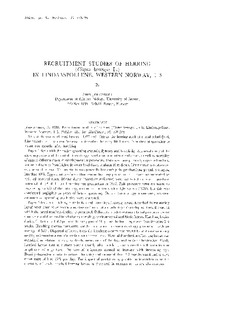| dc.description.abstract | This study was conducted between 1977 and 1980 on the herring stock of a landlocked fjord,
Lindaaspollene in western Norway. It describes the early life history from time of spawning to
about two months after hatching.
Paper 1 deals with the major spawning grounds, Bjørnøy and Syslakvåg. A general study of the
spawning areas and the distribution of eggs in relation to substrate and depth, as well as mortality
of eggs at different stages of development, is presented. The spawn was primarily deposited on hard
bottom substrates from high-tide water level down to about 10 m depth. Little spawn was observed
on fine sand or mud. The mortality was generally low during the pre-hatching period, averaging
less then 10%. Egg densities of more than one million eggs per square meter were accompanied by
reduced survival rates. Diving ducks (Somateria mollissima) were estimated to have a predator
potential of 1/3 of the total herring egg production in 1977. Fish predators were estimated to
remove up to 2/3 of the total egg production in years with light spawn (1978), but this was
considered negligible in years of heavy spawning. On the basis of egg abundance, seasonal
estimates of spawning stock size were obtained.
Paper 2 describes hatching, distribution and mortality of herring larvae. A method for estimating
larval production based on the abundance of larvae at an early stage of development and the rate at
which the larval numbers decline, is presented. Different methods to estimate larval production were
compared and discussed in relation to sampling, environmental and biotic factors. Hatching begins
during the latter half of April and the early part of May, and the hatching season lasts for some 3-4
weeks. Hatching success fluctuated widely in relation to estimates of egg production with an
average of 50%. Dispersal of larvae from the hatching centres was traced intensive sampling
aided by information about the surface water circulation. Vertical distribution of herring larvae was
examined in relation to stage of development, time of the day, and surface illumination. Newly
hatched larvae rose to surface waters shortly after hatching and showed small variations in
amplitude of migration. The vertical migration seemed to increase with increasing age.
Density-dependent mortality between hatching and an age of about 2.5 months was found to have
mean rates of 8 to 16% per day. The impact of predation by planktonic invertebrates on the
mortality of newly hatched herring larvae is discussed in relation to in situ observations.
Paper 3 describes growth, condition and feeding characteristics in relation to abundance and
mortality of herring larvae. Growth and survival were better in 1977 and 1979 than in 1978 and
1980. Mean growth in 1978 was observed to be comparatively slow (0.13 mm/day in lenght and
specific growth rate of 1.1%/day) during the first two weeks after hatching, coinciding with the
first-feeding stage. This was consistent with high mortality which probablywas linked with
environmental conditions. Only prey items of less nutritive value to fish larvae, such as bivalve
larvae, were available at the feeding stage. Only a small fraction of herring larvae survived the
first-feeding stage. Their growth recovered when the feeding conditions improved in May and June
with a new peak production of zooplankton, but their numbers were not sufficient to support a good
year-class. Beyond 20 mm in standard length, corresponding to an age of 50 days after hatching,
net avoidance influenced the size distribution of herring larvae. A feeding period approximately 18
hours, with peak feeding incidence between 0500-1200 hrs, and 1500-2100 hrs, was recorded over
a wide range of larval stages. Mean feeding incidence was observed to be low in herring larvae
younger than two weeks (19%), increasing to 65% in 4-7 weeks old larvae. The diet of herring
larvae consisted primarily of copepod nauplii, while copepodites constituted the main food of larger
larvae. | en |
